Analyzing Cognitive, Social, and Sociocultural Development in Children
VerifiedAdded on 2020/06/04
|7
|1873
|305
Essay
AI Summary
This essay examines the cognitive, social, and sociocultural development of children, using a case study of a child named Jack and his mother, Vanessa. It delves into cognitive development, discussing Piaget's stages of development, and social development, exploring Erikson's psychosocial theory. The essay highlights factors that can influence a child's development, including physical health, parenting styles, environmental factors, and cultural influences. It emphasizes the importance of these developmental stages for a child's learning abilities and social interactions. The relevance of these concepts to nursing and midwifery practices is also discussed, emphasizing the importance of supporting children's health and well-being. The essay concludes by summarizing the importance of effective developmental practices to enhance a child's skills and abilities.

ESSAY
Paraphrase This Document
Need a fresh take? Get an instant paraphrase of this document with our AI Paraphraser

TABLE OF CONTENTS
INTRODUCTION...........................................................................................................................1
TASK...............................................................................................................................................1
CONCLUSION................................................................................................................................4
REFERENCES................................................................................................................................5
INTRODUCTION...........................................................................................................................1
TASK...............................................................................................................................................1
CONCLUSION................................................................................................................................4
REFERENCES................................................................................................................................5
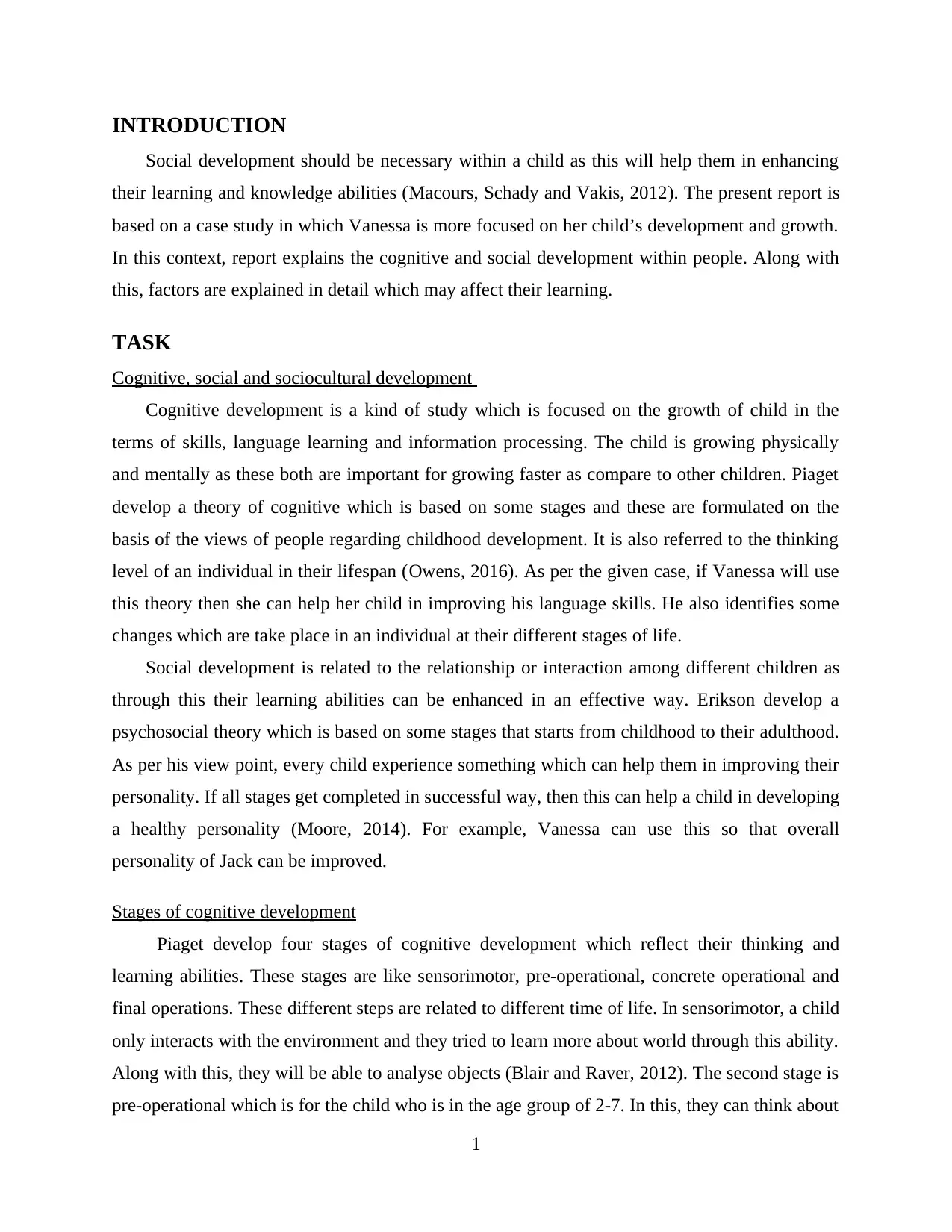
INTRODUCTION
Social development should be necessary within a child as this will help them in enhancing
their learning and knowledge abilities (Macours, Schady and Vakis, 2012). The present report is
based on a case study in which Vanessa is more focused on her child’s development and growth.
In this context, report explains the cognitive and social development within people. Along with
this, factors are explained in detail which may affect their learning.
TASK
Cognitive, social and sociocultural development
Cognitive development is a kind of study which is focused on the growth of child in the
terms of skills, language learning and information processing. The child is growing physically
and mentally as these both are important for growing faster as compare to other children. Piaget
develop a theory of cognitive which is based on some stages and these are formulated on the
basis of the views of people regarding childhood development. It is also referred to the thinking
level of an individual in their lifespan (Owens, 2016). As per the given case, if Vanessa will use
this theory then she can help her child in improving his language skills. He also identifies some
changes which are take place in an individual at their different stages of life.
Social development is related to the relationship or interaction among different children as
through this their learning abilities can be enhanced in an effective way. Erikson develop a
psychosocial theory which is based on some stages that starts from childhood to their adulthood.
As per his view point, every child experience something which can help them in improving their
personality. If all stages get completed in successful way, then this can help a child in developing
a healthy personality (Moore, 2014). For example, Vanessa can use this so that overall
personality of Jack can be improved.
Stages of cognitive development
Piaget develop four stages of cognitive development which reflect their thinking and
learning abilities. These stages are like sensorimotor, pre-operational, concrete operational and
final operations. These different steps are related to different time of life. In sensorimotor, a child
only interacts with the environment and they tried to learn more about world through this ability.
Along with this, they will be able to analyse objects (Blair and Raver, 2012). The second stage is
pre-operational which is for the child who is in the age group of 2-7. In this, they can think about
1
Social development should be necessary within a child as this will help them in enhancing
their learning and knowledge abilities (Macours, Schady and Vakis, 2012). The present report is
based on a case study in which Vanessa is more focused on her child’s development and growth.
In this context, report explains the cognitive and social development within people. Along with
this, factors are explained in detail which may affect their learning.
TASK
Cognitive, social and sociocultural development
Cognitive development is a kind of study which is focused on the growth of child in the
terms of skills, language learning and information processing. The child is growing physically
and mentally as these both are important for growing faster as compare to other children. Piaget
develop a theory of cognitive which is based on some stages and these are formulated on the
basis of the views of people regarding childhood development. It is also referred to the thinking
level of an individual in their lifespan (Owens, 2016). As per the given case, if Vanessa will use
this theory then she can help her child in improving his language skills. He also identifies some
changes which are take place in an individual at their different stages of life.
Social development is related to the relationship or interaction among different children as
through this their learning abilities can be enhanced in an effective way. Erikson develop a
psychosocial theory which is based on some stages that starts from childhood to their adulthood.
As per his view point, every child experience something which can help them in improving their
personality. If all stages get completed in successful way, then this can help a child in developing
a healthy personality (Moore, 2014). For example, Vanessa can use this so that overall
personality of Jack can be improved.
Stages of cognitive development
Piaget develop four stages of cognitive development which reflect their thinking and
learning abilities. These stages are like sensorimotor, pre-operational, concrete operational and
final operations. These different steps are related to different time of life. In sensorimotor, a child
only interacts with the environment and they tried to learn more about world through this ability.
Along with this, they will be able to analyse objects (Blair and Raver, 2012). The second stage is
pre-operational which is for the child who is in the age group of 2-7. In this, they can think about
1
⊘ This is a preview!⊘
Do you want full access?
Subscribe today to unlock all pages.

Trusted by 1+ million students worldwide
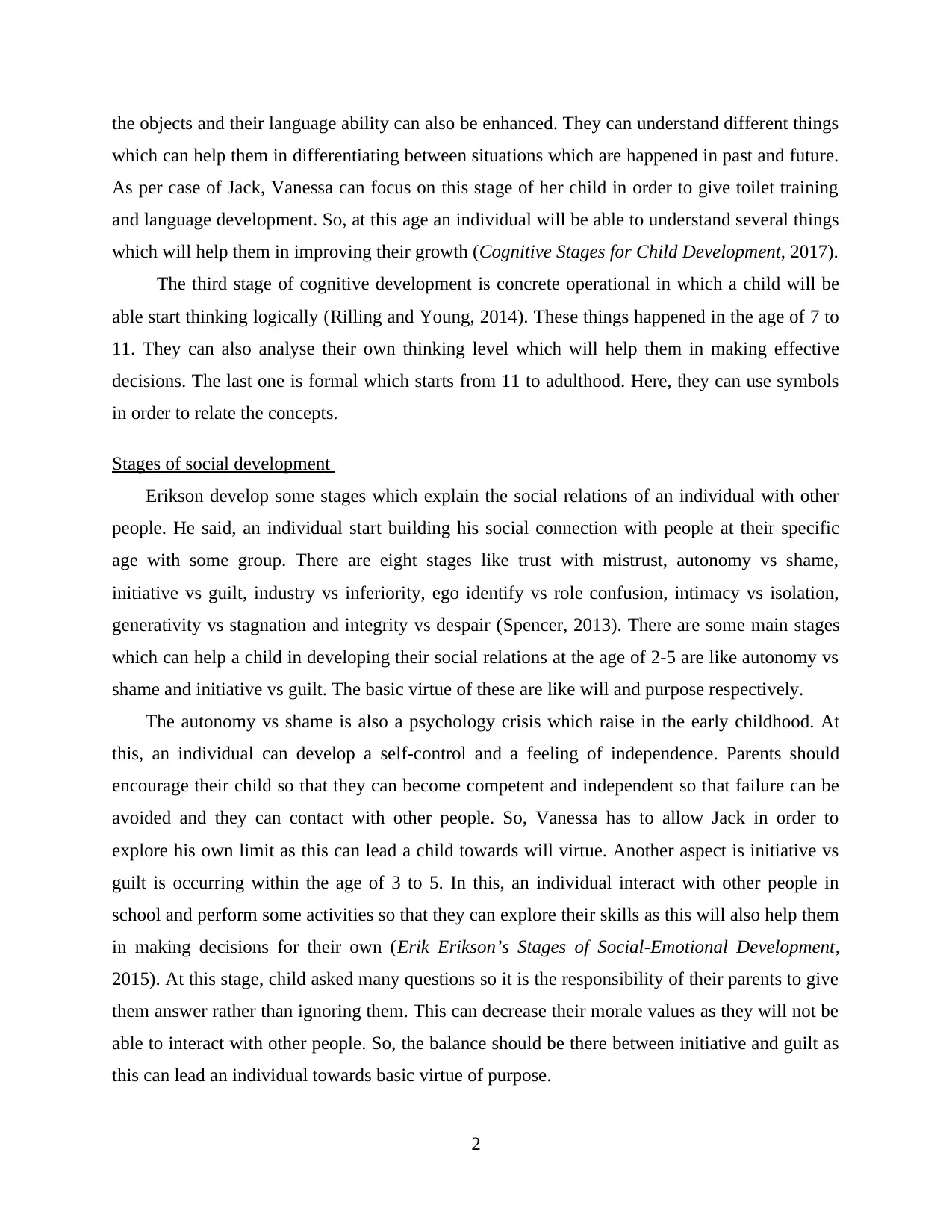
the objects and their language ability can also be enhanced. They can understand different things
which can help them in differentiating between situations which are happened in past and future.
As per case of Jack, Vanessa can focus on this stage of her child in order to give toilet training
and language development. So, at this age an individual will be able to understand several things
which will help them in improving their growth (Cognitive Stages for Child Development, 2017).
The third stage of cognitive development is concrete operational in which a child will be
able start thinking logically (Rilling and Young, 2014). These things happened in the age of 7 to
11. They can also analyse their own thinking level which will help them in making effective
decisions. The last one is formal which starts from 11 to adulthood. Here, they can use symbols
in order to relate the concepts.
Stages of social development
Erikson develop some stages which explain the social relations of an individual with other
people. He said, an individual start building his social connection with people at their specific
age with some group. There are eight stages like trust with mistrust, autonomy vs shame,
initiative vs guilt, industry vs inferiority, ego identify vs role confusion, intimacy vs isolation,
generativity vs stagnation and integrity vs despair (Spencer, 2013). There are some main stages
which can help a child in developing their social relations at the age of 2-5 are like autonomy vs
shame and initiative vs guilt. The basic virtue of these are like will and purpose respectively.
The autonomy vs shame is also a psychology crisis which raise in the early childhood. At
this, an individual can develop a self-control and a feeling of independence. Parents should
encourage their child so that they can become competent and independent so that failure can be
avoided and they can contact with other people. So, Vanessa has to allow Jack in order to
explore his own limit as this can lead a child towards will virtue. Another aspect is initiative vs
guilt is occurring within the age of 3 to 5. In this, an individual interact with other people in
school and perform some activities so that they can explore their skills as this will also help them
in making decisions for their own (Erik Erikson’s Stages of Social-Emotional Development,
2015). At this stage, child asked many questions so it is the responsibility of their parents to give
them answer rather than ignoring them. This can decrease their morale values as they will not be
able to interact with other people. So, the balance should be there between initiative and guilt as
this can lead an individual towards basic virtue of purpose.
2
which can help them in differentiating between situations which are happened in past and future.
As per case of Jack, Vanessa can focus on this stage of her child in order to give toilet training
and language development. So, at this age an individual will be able to understand several things
which will help them in improving their growth (Cognitive Stages for Child Development, 2017).
The third stage of cognitive development is concrete operational in which a child will be
able start thinking logically (Rilling and Young, 2014). These things happened in the age of 7 to
11. They can also analyse their own thinking level which will help them in making effective
decisions. The last one is formal which starts from 11 to adulthood. Here, they can use symbols
in order to relate the concepts.
Stages of social development
Erikson develop some stages which explain the social relations of an individual with other
people. He said, an individual start building his social connection with people at their specific
age with some group. There are eight stages like trust with mistrust, autonomy vs shame,
initiative vs guilt, industry vs inferiority, ego identify vs role confusion, intimacy vs isolation,
generativity vs stagnation and integrity vs despair (Spencer, 2013). There are some main stages
which can help a child in developing their social relations at the age of 2-5 are like autonomy vs
shame and initiative vs guilt. The basic virtue of these are like will and purpose respectively.
The autonomy vs shame is also a psychology crisis which raise in the early childhood. At
this, an individual can develop a self-control and a feeling of independence. Parents should
encourage their child so that they can become competent and independent so that failure can be
avoided and they can contact with other people. So, Vanessa has to allow Jack in order to
explore his own limit as this can lead a child towards will virtue. Another aspect is initiative vs
guilt is occurring within the age of 3 to 5. In this, an individual interact with other people in
school and perform some activities so that they can explore their skills as this will also help them
in making decisions for their own (Erik Erikson’s Stages of Social-Emotional Development,
2015). At this stage, child asked many questions so it is the responsibility of their parents to give
them answer rather than ignoring them. This can decrease their morale values as they will not be
able to interact with other people. So, the balance should be there between initiative and guilt as
this can lead an individual towards basic virtue of purpose.
2
Paraphrase This Document
Need a fresh take? Get an instant paraphrase of this document with our AI Paraphraser
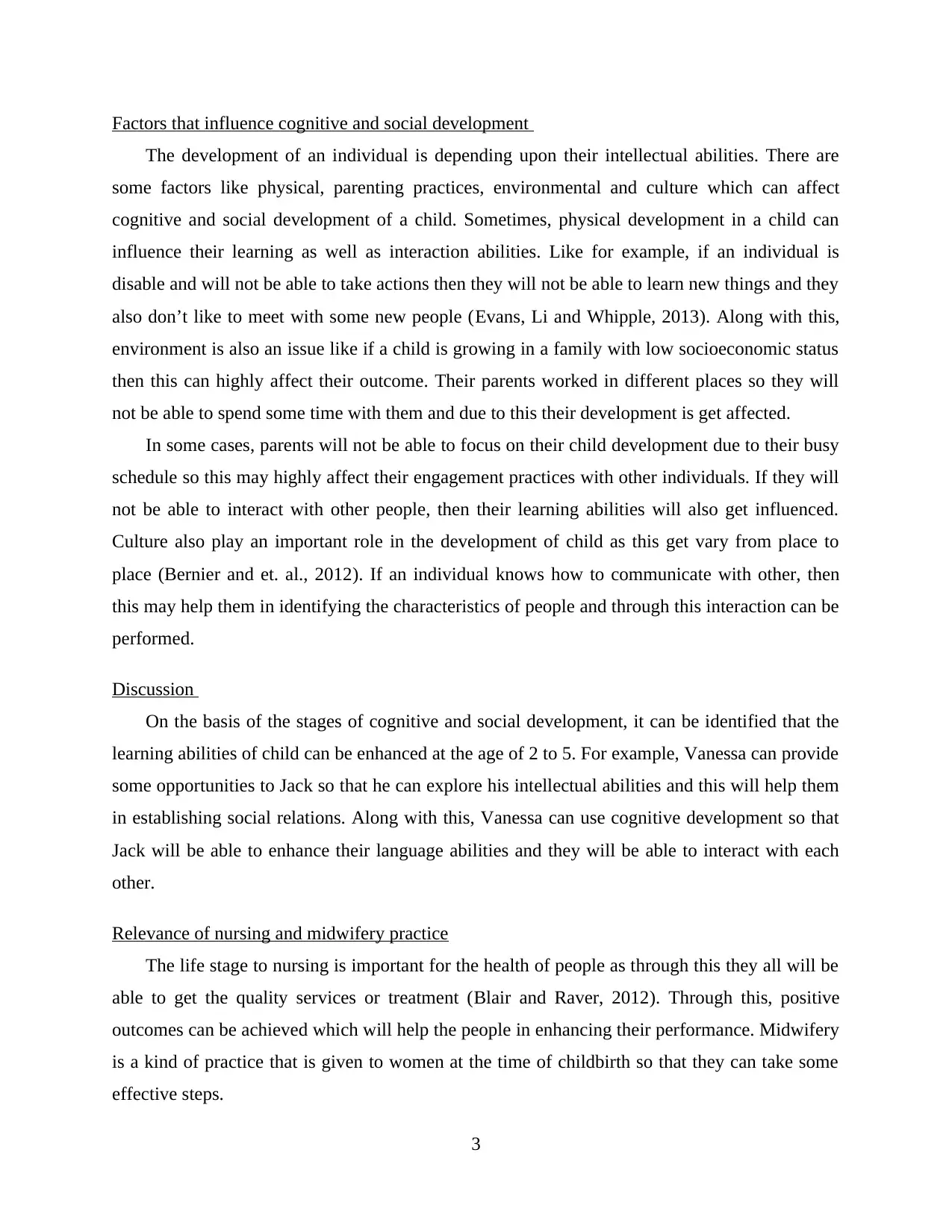
Factors that influence cognitive and social development
The development of an individual is depending upon their intellectual abilities. There are
some factors like physical, parenting practices, environmental and culture which can affect
cognitive and social development of a child. Sometimes, physical development in a child can
influence their learning as well as interaction abilities. Like for example, if an individual is
disable and will not be able to take actions then they will not be able to learn new things and they
also don’t like to meet with some new people (Evans, Li and Whipple, 2013). Along with this,
environment is also an issue like if a child is growing in a family with low socioeconomic status
then this can highly affect their outcome. Their parents worked in different places so they will
not be able to spend some time with them and due to this their development is get affected.
In some cases, parents will not be able to focus on their child development due to their busy
schedule so this may highly affect their engagement practices with other individuals. If they will
not be able to interact with other people, then their learning abilities will also get influenced.
Culture also play an important role in the development of child as this get vary from place to
place (Bernier and et. al., 2012). If an individual knows how to communicate with other, then
this may help them in identifying the characteristics of people and through this interaction can be
performed.
Discussion
On the basis of the stages of cognitive and social development, it can be identified that the
learning abilities of child can be enhanced at the age of 2 to 5. For example, Vanessa can provide
some opportunities to Jack so that he can explore his intellectual abilities and this will help them
in establishing social relations. Along with this, Vanessa can use cognitive development so that
Jack will be able to enhance their language abilities and they will be able to interact with each
other.
Relevance of nursing and midwifery practice
The life stage to nursing is important for the health of people as through this they all will be
able to get the quality services or treatment (Blair and Raver, 2012). Through this, positive
outcomes can be achieved which will help the people in enhancing their performance. Midwifery
is a kind of practice that is given to women at the time of childbirth so that they can take some
effective steps.
3
The development of an individual is depending upon their intellectual abilities. There are
some factors like physical, parenting practices, environmental and culture which can affect
cognitive and social development of a child. Sometimes, physical development in a child can
influence their learning as well as interaction abilities. Like for example, if an individual is
disable and will not be able to take actions then they will not be able to learn new things and they
also don’t like to meet with some new people (Evans, Li and Whipple, 2013). Along with this,
environment is also an issue like if a child is growing in a family with low socioeconomic status
then this can highly affect their outcome. Their parents worked in different places so they will
not be able to spend some time with them and due to this their development is get affected.
In some cases, parents will not be able to focus on their child development due to their busy
schedule so this may highly affect their engagement practices with other individuals. If they will
not be able to interact with other people, then their learning abilities will also get influenced.
Culture also play an important role in the development of child as this get vary from place to
place (Bernier and et. al., 2012). If an individual knows how to communicate with other, then
this may help them in identifying the characteristics of people and through this interaction can be
performed.
Discussion
On the basis of the stages of cognitive and social development, it can be identified that the
learning abilities of child can be enhanced at the age of 2 to 5. For example, Vanessa can provide
some opportunities to Jack so that he can explore his intellectual abilities and this will help them
in establishing social relations. Along with this, Vanessa can use cognitive development so that
Jack will be able to enhance their language abilities and they will be able to interact with each
other.
Relevance of nursing and midwifery practice
The life stage to nursing is important for the health of people as through this they all will be
able to get the quality services or treatment (Blair and Raver, 2012). Through this, positive
outcomes can be achieved which will help the people in enhancing their performance. Midwifery
is a kind of practice that is given to women at the time of childbirth so that they can take some
effective steps.
3
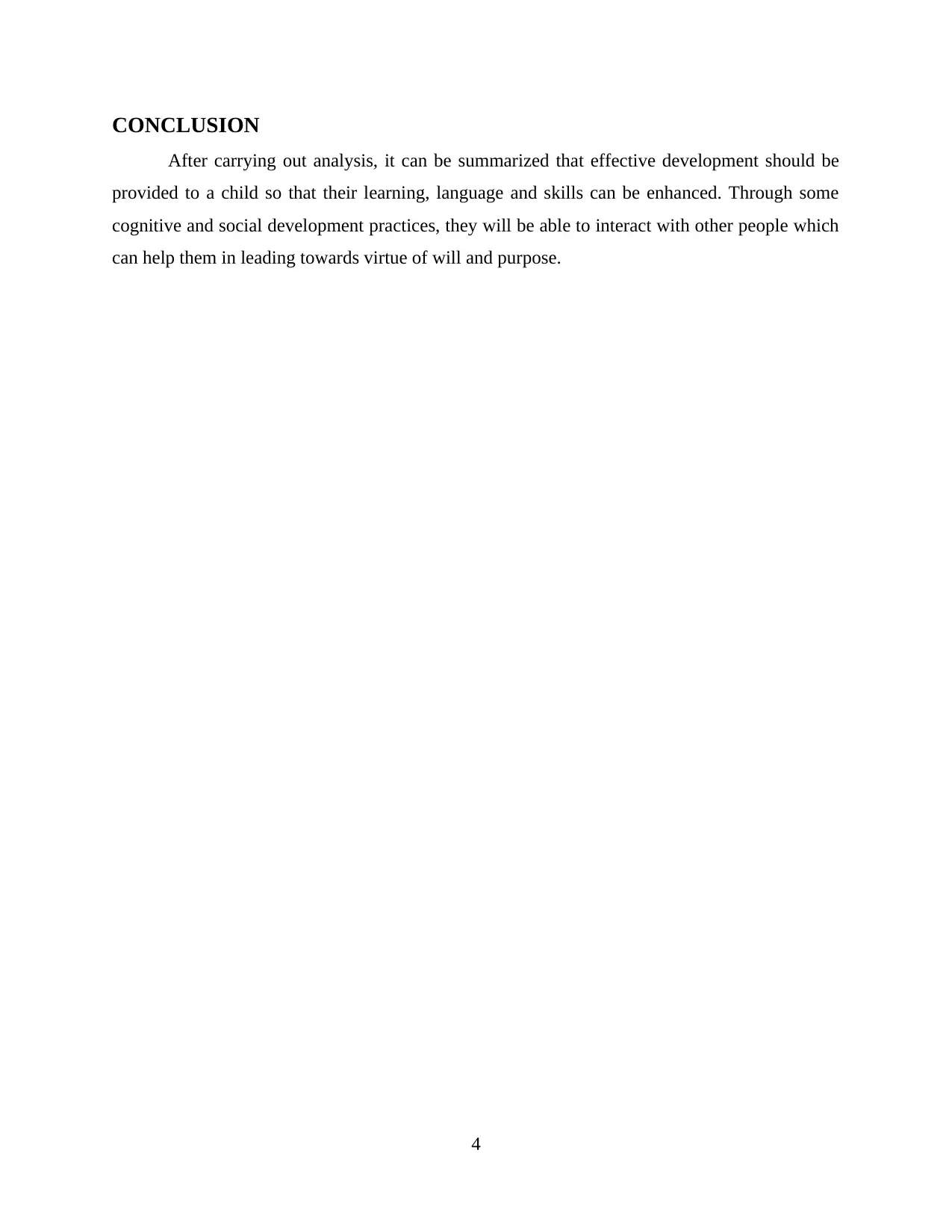
CONCLUSION
After carrying out analysis, it can be summarized that effective development should be
provided to a child so that their learning, language and skills can be enhanced. Through some
cognitive and social development practices, they will be able to interact with other people which
can help them in leading towards virtue of will and purpose.
4
After carrying out analysis, it can be summarized that effective development should be
provided to a child so that their learning, language and skills can be enhanced. Through some
cognitive and social development practices, they will be able to interact with other people which
can help them in leading towards virtue of will and purpose.
4
⊘ This is a preview!⊘
Do you want full access?
Subscribe today to unlock all pages.

Trusted by 1+ million students worldwide
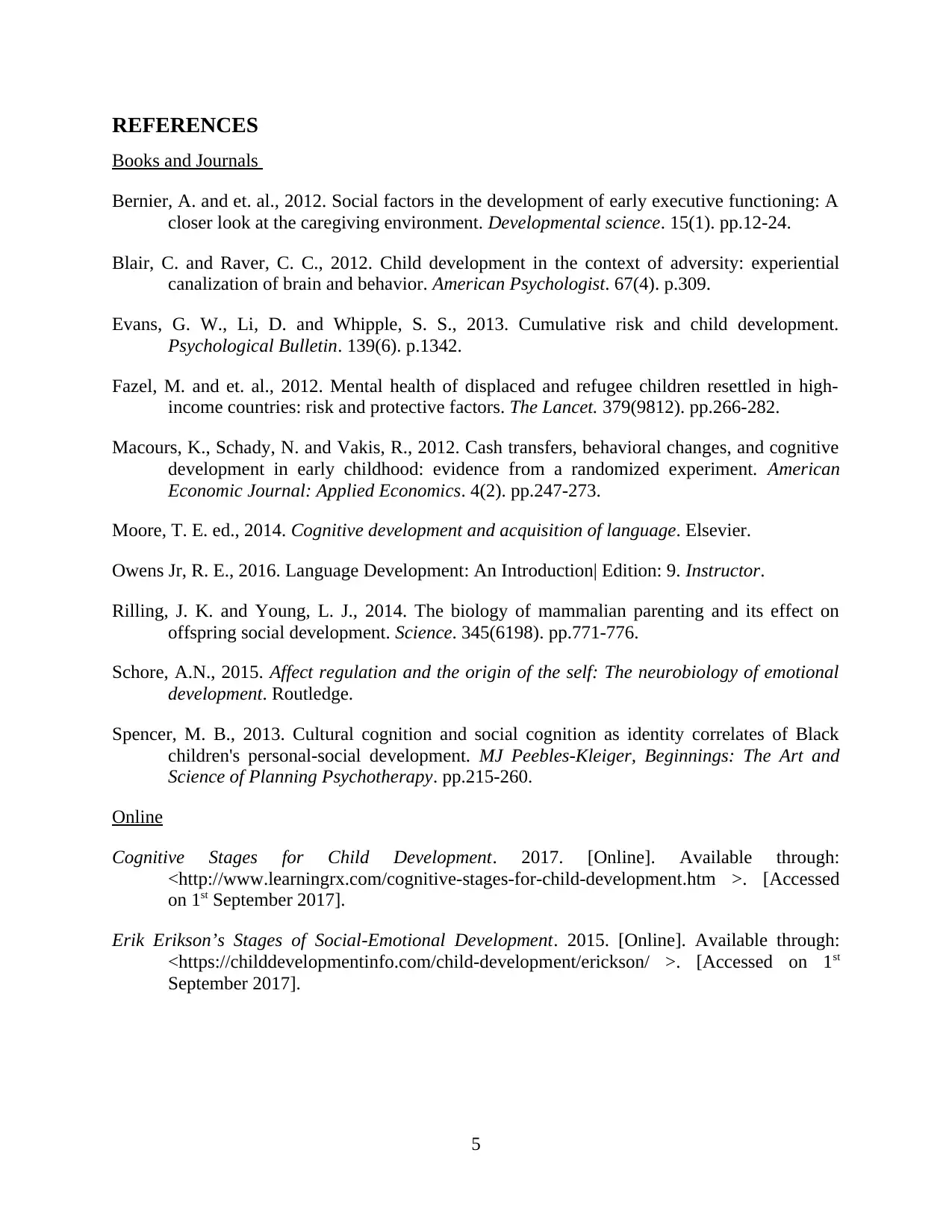
REFERENCES
Books and Journals
Bernier, A. and et. al., 2012. Social factors in the development of early executive functioning: A
closer look at the caregiving environment. Developmental science. 15(1). pp.12-24.
Blair, C. and Raver, C. C., 2012. Child development in the context of adversity: experiential
canalization of brain and behavior. American Psychologist. 67(4). p.309.
Evans, G. W., Li, D. and Whipple, S. S., 2013. Cumulative risk and child development.
Psychological Bulletin. 139(6). p.1342.
Fazel, M. and et. al., 2012. Mental health of displaced and refugee children resettled in high-
income countries: risk and protective factors. The Lancet. 379(9812). pp.266-282.
Macours, K., Schady, N. and Vakis, R., 2012. Cash transfers, behavioral changes, and cognitive
development in early childhood: evidence from a randomized experiment. American
Economic Journal: Applied Economics. 4(2). pp.247-273.
Moore, T. E. ed., 2014. Cognitive development and acquisition of language. Elsevier.
Owens Jr, R. E., 2016. Language Development: An Introduction| Edition: 9. Instructor.
Rilling, J. K. and Young, L. J., 2014. The biology of mammalian parenting and its effect on
offspring social development. Science. 345(6198). pp.771-776.
Schore, A.N., 2015. Affect regulation and the origin of the self: The neurobiology of emotional
development. Routledge.
Spencer, M. B., 2013. Cultural cognition and social cognition as identity correlates of Black
children's personal-social development. MJ Peebles-Kleiger, Beginnings: The Art and
Science of Planning Psychotherapy. pp.215-260.
Online
Cognitive Stages for Child Development. 2017. [Online]. Available through:
<http://www.learningrx.com/cognitive-stages-for-child-development.htm >. [Accessed
on 1st September 2017].
Erik Erikson’s Stages of Social-Emotional Development. 2015. [Online]. Available through:
<https://childdevelopmentinfo.com/child-development/erickson/ >. [Accessed on 1st
September 2017].
5
Books and Journals
Bernier, A. and et. al., 2012. Social factors in the development of early executive functioning: A
closer look at the caregiving environment. Developmental science. 15(1). pp.12-24.
Blair, C. and Raver, C. C., 2012. Child development in the context of adversity: experiential
canalization of brain and behavior. American Psychologist. 67(4). p.309.
Evans, G. W., Li, D. and Whipple, S. S., 2013. Cumulative risk and child development.
Psychological Bulletin. 139(6). p.1342.
Fazel, M. and et. al., 2012. Mental health of displaced and refugee children resettled in high-
income countries: risk and protective factors. The Lancet. 379(9812). pp.266-282.
Macours, K., Schady, N. and Vakis, R., 2012. Cash transfers, behavioral changes, and cognitive
development in early childhood: evidence from a randomized experiment. American
Economic Journal: Applied Economics. 4(2). pp.247-273.
Moore, T. E. ed., 2014. Cognitive development and acquisition of language. Elsevier.
Owens Jr, R. E., 2016. Language Development: An Introduction| Edition: 9. Instructor.
Rilling, J. K. and Young, L. J., 2014. The biology of mammalian parenting and its effect on
offspring social development. Science. 345(6198). pp.771-776.
Schore, A.N., 2015. Affect regulation and the origin of the self: The neurobiology of emotional
development. Routledge.
Spencer, M. B., 2013. Cultural cognition and social cognition as identity correlates of Black
children's personal-social development. MJ Peebles-Kleiger, Beginnings: The Art and
Science of Planning Psychotherapy. pp.215-260.
Online
Cognitive Stages for Child Development. 2017. [Online]. Available through:
<http://www.learningrx.com/cognitive-stages-for-child-development.htm >. [Accessed
on 1st September 2017].
Erik Erikson’s Stages of Social-Emotional Development. 2015. [Online]. Available through:
<https://childdevelopmentinfo.com/child-development/erickson/ >. [Accessed on 1st
September 2017].
5
1 out of 7
Related Documents
Your All-in-One AI-Powered Toolkit for Academic Success.
+13062052269
info@desklib.com
Available 24*7 on WhatsApp / Email
![[object Object]](/_next/static/media/star-bottom.7253800d.svg)
Unlock your academic potential
Copyright © 2020–2025 A2Z Services. All Rights Reserved. Developed and managed by ZUCOL.





